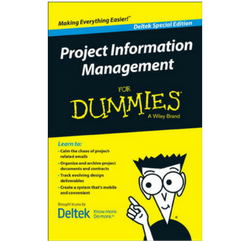4 Types Of Project Information You Should Use PIM Software To Manage

As a project-centric business there are probably times when you wish that you had better control over the information flowing in and out of your business and projects.
With a multitude of emails, contracts, drawings and other design deliverables and documentation being created as part of each and every project you work on, ensuring that it’s all managed correctly is key to successful delivery.
That’s where Project Information Management (PIM) comes in.
What Is PIM And What Types Of Project Information Should You Manage?
Put simply, Project Information Management incorporates the processes and systems that you use to manage all of your project information. As an architect, engineer, contractor or construction consultant who wants to ensure that your projects are delivered on time and to budget, managing your documents and information efficiently is essential.
The 4 types of project information you should manage as part of your PIM strategy are:
1. Emails
We all suffer from email overload at some point or another; it’s the primary communication tool for many organisations and is an easy way to distribute project related information and documentation.
Many of us have our own systems that we use to file and store the emails that we receive. However, often this works for a single person but not the project team as a whole, it creates information silos and leaves the organisation open to the risks that come from lost or deleted emails and attachments.
A PIM strategy and system offers all of the tools and processes needed to ensure that emails are stored, catalogued and controlled in an efficient, risk-free way.
People spend nearly 2-3 hours a day on email-related activities, consuming 20-30% of their business day.
Organisations with Project Information Management systems spend minutes, not hours, with email.
2. Documentation
Ask yourself these questions:
- How easy is it to find the project documentation that you need when you need it?
- Are you always 100% sure that you’re working on the right version of the document that you are editing and could you easily go back to previous versions if required?
- What controls do you have in place for the sign off, distribution and editing of your project documentation?
If you are like most project-centric businesses, you are not managing your project documentation as effectively as you could. Your project timelines and profitability are affected by time wasted searching for documentation in multiple places, lost information and errors made due to lack of version and document control.
As with emails, having a PIM strategy in place will ensure that all project documentation is securely stored and catalogued and is easy to locate when needed. Only 9% of businesses have a single enterprise-wide collaboration system. Yet, 75% believe sharing documents is the most important way to improve collaboration.
3. Design Deliverables
Creating and sharing design deliverables, from drawings and diagrams to schedules, specifications and health and safety risk assessments is a crucial part of any construction project.
To ensure that this is all done as efficiently as possible, having the right processes and systems in place is essential.
Using PIM software to manage your design deliverables will enable you to control the storage, classification, editing and distribution of your drawings, diagrams, specifications and other documentation.
4. Contracts
Your contract documentation sets out the expectations of your clients and the entire project team, therefore these legally binding documents need to be stored and managed correctly.
In a dispute, the quick retrieval of this type of documentation could save you a lot of money.
PIM software should be used to manage all contract documentation, such as change orders, interim and final valuations and completion certificates to ensure you can get hold of the information you need, when you need it.
Understanding Project Information Management - An Introduction Series
- What Is PIM And Why Do You Need It?
- 5 Reasons Why Your AEC Firm Needs Project Information Management
- Project Information Management is changing the AEC Industry
- Managing Multiple Projects? Here Are 6 Ways To Ensure You Master Email Management
- The Fundamentals Of Managing Design Deliverables
- How Mobile Working Can Benefit Your Construction Firm
Want to learn more?
For more information on how implementing a Project Information Management strategy and system will benefit your business, download our Project Information Management for Dummies eBook.

Deltek Project Nation Newsletter
Subscribe to receive the latest news and best practices across a range of relevant topics and industries.




